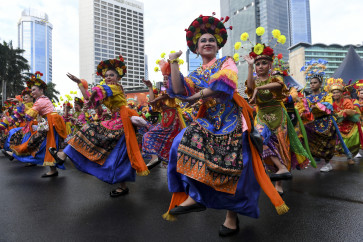Popular Reads
Top Results
Can't find what you're looking for?
View all search resultsPopular Reads
Top Results
Can't find what you're looking for?
View all search resultsBook sheds light on Kartosoewirjo’s last day
Last day: Sekarmadji Maridjan Kartosoewirjo (center), leader of the Darul Islam (DI) movement and the Indonesian Islamic State (NII) leader, is surrounded by soldiers en route to Ubi Island, just north of Jakarta, where he was executed and buried in September 1962Political activist Fadli Zon released an illustrated book on Wednesday about the demise of the controversial leader of the Darul Islam (DI) movement and the West Java-based Indonesian Islamic State (NII), Sekarmadji Maridjan Kartosoewirjo, 50 years after his execution in September 1962
Change text size
Gift Premium Articles
to Anyone
L
span class="caption" style="width: 557px;">Last day: Sekarmadji Maridjan Kartosoewirjo (center), leader of the Darul Islam (DI) movement and the Indonesian Islamic State (NII) leader, is surrounded by soldiers en route to Ubi Island, just north of Jakarta, where he was executed and buried in September 1962
Political activist Fadli Zon released an illustrated book on Wednesday about the demise of the controversial leader of the Darul Islam (DI) movement and the West Java-based Indonesian Islamic State (NII), Sekarmadji Maridjan Kartosoewirjo, 50 years after his execution in September 1962.
The book is the first publication to visually document the last day of the Muslim leader, who was sentenced to death for treason.
The book said that Kartosoewirjo was executed on Ubi Island, in Thousand Islands regency, just north of Jakarta, putting an end to speculation that he was executed and buried on Onrust Island, 3 kilometers from Ubi Island.
Fadli hoped that the book would clear up some confusion.
“History is written by the victors. But we need to know who Kartosoewirjo really was. Many people went to Onrust Island because they thought he was buried there. Even his family didn’t know exactly where their father and grandfather was buried,” Fadli said during the book launch in Cikini, Jakarta.
The book has 81 pictures, arranged in chronological order from his last supper with his wife and children until his burial.
There are also graphic photos where soldiers removed his body from the cross soon after he faced the firing squad.
“From the pictures we learned that the execution was carried out according to Islamic teachings and that he was treated humanely during the period leading up to the execution,” he said.
Fadli said that he had bought the 81 pictures from a collector whom he declined to identify in an auction two years ago in downtown Jakarta. The same pictures were also kept in the National Archives under the category of unpublished documents.
“However, the ones kept by the National Archives were without captions, while the ones I got were with captions,” he said.
Kartosoewirjo’s youngest son, Sardjono Kartosoewirjo, lauded the book’s publication, and said that it could shed new light on the country’s past.
“Many of us never knew the real story. Now it is crystal clear, including where my father was executed and buried,” Sardjono said.
Sardjono said that he learned the truth about his father from the book.
“Me and my family will soon go to Ubi Island to send him a prayer,” he added.
Fadli maintained that Kartosoewirjo was one of the most important figures in the country’s history, as he took part in the Sumpah Pemuda (Youth Pledge) in 1928, representing Jong Java’s (Javanese youth) Surabaya chapter.
In an interview with American journalist Cindy Adams, the country’s first president, Sukarno, referred to Kartosoewirjo as his best friend, with whom he shared his dreams.
Kartosoewirjo founded the NII in August 1949 as a result of his disappointment with the Renville Agreement signed by representatives of the Republic of Indonesia and the Dutch on Jan. 19, 1948, which allowed the Dutch to only recognize Central Java, Yogyakarta and Sumatra as the territory of the new republic.
— Photo by P.J. Leo










